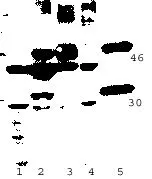![ELISA analysis of antigen using GTX60407 p63 antibody [4E5]. Red : Control antigen 100ng Purple : Antigen 10ng Green : Antigen 50ng Blue : Antigen 100ng ELISA analysis of antigen using GTX60407 p63 antibody [4E5]. Red : Control antigen 100ng Purple : Antigen 10ng Green : Antigen 50ng Blue : Antigen 100ng](https://www.genetex.com/upload/website/prouct_img/normal/GTX60407/GTX60407_20170912_ELISA_w_23061123_931.webp)
ELISA analysis of antigen using GTX60407 p63 antibody [4E5]. Red : Control antigen 100ng Purple : Antigen 10ng Green : Antigen 50ng Blue : Antigen 100ng
p63 antibody [4E5]
GTX60407
ApplicationsWestern Blot, ELISA, ImmunoHistoChemistry, ImmunoHistoChemistry Paraffin
Product group Antibodies
TargetTP63
Overview
- SupplierGeneTex
- Product Namep63 antibody [4E5]
- Delivery Days Customer9
- Application Supplier NoteWB: 1/500 - 1/2000. IHC-P: 1/200 - 1/1000. ELISA: 1/10000. *Optimal dilutions/concentrations should be determined by the researcher.Not tested in other applications.
- ApplicationsWestern Blot, ELISA, ImmunoHistoChemistry, ImmunoHistoChemistry Paraffin
- CertificationResearch Use Only
- ClonalityMonoclonal
- ConjugateUnconjugated
- Gene ID8626
- Target nameTP63
- Target descriptiontumor protein p63
- Target synonymsAIS, B(p51A), B(p51B), EEC3, KET, LMS, NBP, OFC8, RHS, SHFM4, TP53CP, TP53L, TP73L, p40, p51, p53CP, p63, p73H, p73L, tumor protein 63, amplified in squamous cell carcinoma, chronic ulcerative stomatitis protein, keratinocyte transcription factor KET, transformation-related protein 63, tumor protein p53-competing protein
- HostMouse
- IsotypeIgG1
- Protein IDQ9H3D4
- Protein NameTumor protein 63
- Scientific DescriptionThis gene encodes a member of the p53 family of transcription factors. An animal model, p63 -/- mice, has been useful in defining the role this protein plays in the development and maintenance of stratified epithelial tissues. p63 -/- mice have several developmental defects which include the lack of limbs and other tissues, such as teeth and mammary glands, which develop as a result of interactions between mesenchyme and epithelium. Mutations in this gene are associated with ectodermal dysplasia, and cleft lip/palate syndrome 3 (EEC3); split-hand/foot malformation 4 (SHFM4); ankyloblepharon-ectodermal defects-cleft lip/palate; ADULT syndrome (acro-dermato-ungual-lacrimal-tooth); limb-mammary syndrome; Rap-Hodgkin syndrome (RHS); and orofacial cleft 8. Both alternative splicing and the use of alternative promoters results in multiple transcript variants encoding different proteins. Many transcripts encoding different proteins have been reported but the biological validity and the full-l
- Storage Instruction-20°C or -80°C,2°C to 8°C
- UNSPSC12352203

![IHC-P analysis of ovarian cancer (left) and lung cancer (right) using GTX60407 p63 antibody [4E5]. IHC-P analysis of ovarian cancer (left) and lung cancer (right) using GTX60407 p63 antibody [4E5].](https://www.genetex.com/upload/website/prouct_img/normal/GTX60407/GTX60407_20170912_IHC-P_w_23061123_991.webp)
![WB analysis of A431 (1), HeLa (2), Jurkat (3), THP-1 (4), NIH3T3 (5), Cos7 (6) and PC-12 (7) cell lysate using GTX60407 p63 antibody [4E5]. WB analysis of A431 (1), HeLa (2), Jurkat (3), THP-1 (4), NIH3T3 (5), Cos7 (6) and PC-12 (7) cell lysate using GTX60407 p63 antibody [4E5].](https://www.genetex.com/upload/website/prouct_img/normal/GTX60407/GTX60407_20170912_WB_w_23061123_286.webp)

![IHC-P analysis of human prostate carcinoma tissue using GTX18022 p63 antibody [TP63/2427].](https://www.genetex.com/upload/website/prouct_img/normal/GTX18022/GTX18022_20200115_IHC-P_1044_w_23060620_814.webp)
![IHC-P analysis of human prostate carcinoma tissue using GTX18023 p63 antibody [TP63/2428].](https://www.genetex.com/upload/website/prouct_img/normal/GTX18023/GTX18023_20200115_IHC-P_1045_w_23060620_173.webp)

![IHC-P analysis of human prostate tissue using GTX01961 p63 antibody [7JUL].](https://www.genetex.com/upload/website/prouct_img/normal/GTX01961/GTX01961_20200811_IHC-P_68_w_23053121_325.webp)
